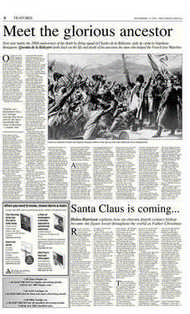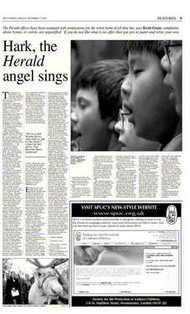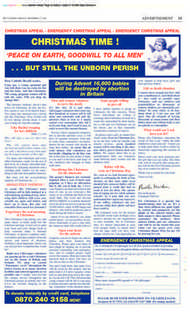Page 8, 17th December 2004
Page 8

Report an error
Noticed an error on this page?If you've noticed an error in this article please click here to report it.
Tags
Share
Related articles
Don't Tread On Our Dreams
How Christmas Gifts Are Brought To Many Lands
Let Us Al! Join
Who Is Santa Claus ?
Christmas With The Polar Bears
Santa Claus is coming...
Helen Harrison explains how an obscure fourth-century bishop
became the figure loved throughout the world as Father Christmas
Recent years have seen an increasing trend towards acknowledging the real St Nicholas during the build-up to Christmas, instead of just paying lipservice to him via the commercial Santa Claus.
For centuries, it has been the tradition in some European countries to exchange simple gifts around the saint’s feast day on December 6, allowing Christmas Day to be preserved for the worship of the Christ Child.
Over the last decade there has been an increase in the number of festivals to celebrate him in Britain. But who was he, and what is his status today?
When the Church calendar was revised in 1968, it became optional for faithful Catholics to celebrate St Nicholas’s Feast Day, but there’s no doubt that he really existed and he remained a most popular saint.
St Nicholas is the patron of labourers and paupers, thieves and murderers, as well as bankers, scholars, brewers, brides, pawnbrokers, and perfumers.
He is also the chosen protector of countries, and numerous churches and cities in Britain including Liverpool, Portsmouth and Aberdeen.
Many of the stories atttributed to St Nicholas are apocryphal, but there are some solid historical facts. He was Bishop of Myra, an important port in Lycia, now Turkey, in the mid fourth century. Born into a wealthy family, his parents died when he was still young and he reputedly gave away his inheritance to the poor and needy, dedicating his life to serving God.
Some accounts say he attended the Council of Nicaea in 325 AD, others, that he was imprisoned by the tyrant Emperor Diocletian.
Nicholas’s charity and holiness were the subject of popular legend soon after his death, and certainly by the early sixth century when the Emperor Justinian I built a basilica in his honour in Constantinople.
When the Muslim Saracens conquered Myra there was competition between several Italian cities to acquire his relics. The phenomenon known as Manna di S Nicola was said to exude from his tomb, attracting many pilgrims. In 1087 the remains were moved to Bari in southern Italy and a new church was built for them – the Basilica di San Nicola. His shrine there became one of medieval Europe’s greatest centres of pilgrimage.
Nicholas was known as the patron saint of children and young people long before his image was taken over and transformed, firstly into Sinterklaas/Santa Claus after the Reformation and, in the 19th century, into the ubiquitous Father Christmas.
This came about when traditions associated with him were carried to America by European settlers. He had always been seen as a bringer of gifts and presents, usually portrayed in his bishop’s robes. In the New World, this colourful image was readily transformed into the familiar commercial and secular Father Christmas that we know today.
There are numerous stories of his kindness to young people and his miracles in connection with them. Many tell of children rescued from disasters and returned to their families. He is credited with saving three sisters, who were unable to afford dowries, from lives of slavery and prostitution. Secretly, one night, he threw down their chimney three purses of gold which landed in stockings that were hanging up to dry – the origin of our own Christmas stockings. Some versions of the story describe three balls of gold being tossed into the house. These, sometimes depicted as three oranges, have become one of the most popular symbols associated with him.
Another story relates how three young men, often described as theology students, were robbed and murdered by an innkeeper who hid their remains in a large barrel. Nicholas stopped at the inn, dreamed of the crime, confronted the innkeeper and the men were restored to life.
He is also the patron of sailors and voyagers. While travelling to Alexandria, he saved the life of a sailor who had fallen from the rigging. Returning by sea from the Holy Land, he prayed while a mighty storm raged – and the wind and the waves were calmed.
Today, icons of the saint surrounded by model ships made of silver or carved wood are still found in Mediterranean ports, placed there by sailors safely returned home. In the Aegean and Ionian seas, voyagers follow the Star of St Nicholas and you may still hear the expression: “May St Nicholas hold the tiller.” In medieval England around 400 churches were dedicated to him and he is said to have been represented by Christian artists more frequently than any saint except Our Lady. His image is that found most frequently on Byzantine seals. With St Andrew, he is patron saint of Russia. He was enormously popular preRevolution, and so many Russian pilgrims used to come to Bari that the government supported a church, a hospital and a hospice in the town.
Today, the Russian Orthodox Church still observes the feast of his translation and he is named in the preparation of the Byzantine Mass.
St Nicholas is recognised as the friend and protector of all those in trouble or need, reflecting his concern for justice and for victims.
An exhibition charting the evolution of Father Christmas is currently running at Newcastle Cathedral. Visit it and discover the true story of one of the world’s most loved figures.
From St Nicholas to Father Christmas is at Newcastle Cathedral until December 31
blog comments powered by Disqus

















